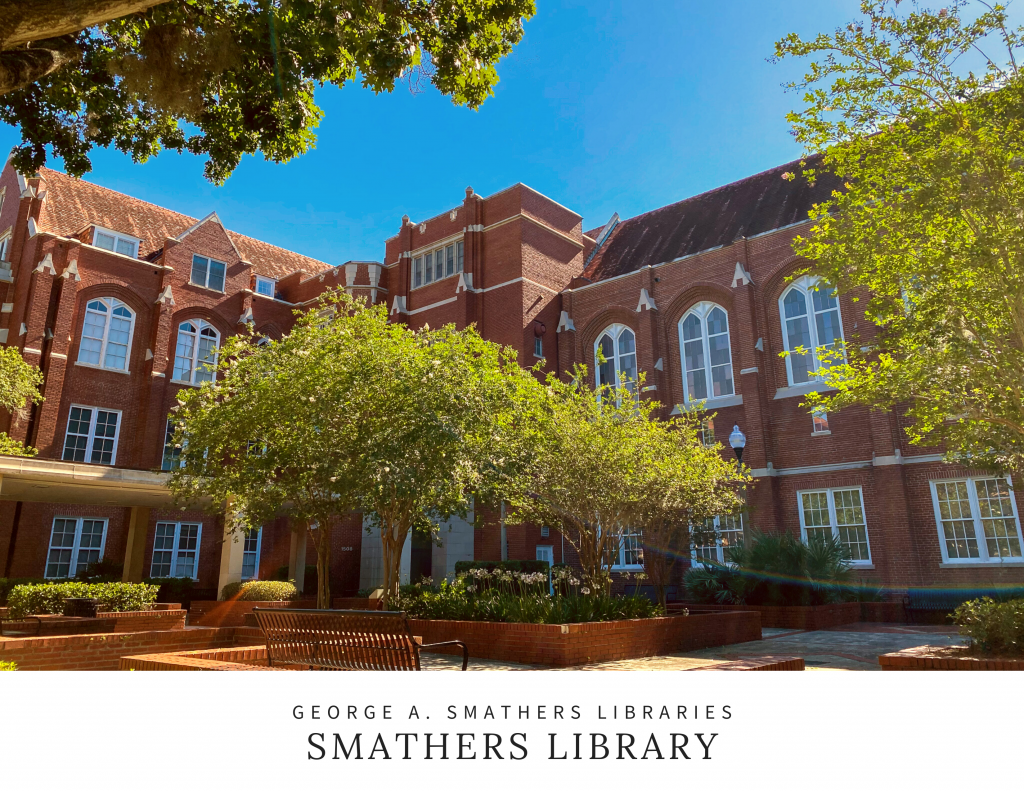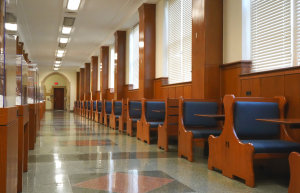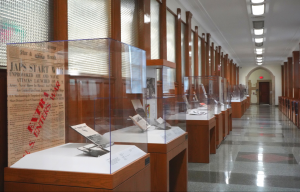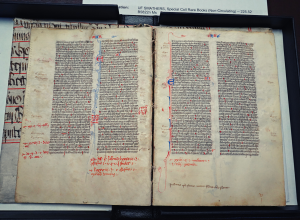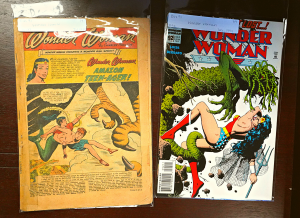Visiting the George A. Smathers Libraries
16 Smathers Library
Smathers Library at a Glance
- Quiet study areas where you can be immersed in history
- Centrally located just a few steps from Plaza of the Americas
- Hold historic and rare items in your hands, for research project or just for your own personal curiosity!
- Rotating exhibits to browse while taking a study break
- Some of the most beautiful spaces on campus
Explore Smathers Library
Smathers Library (historically known as Library East) holds the title of being the first library at the University of Florida. Smathers Library was founded in 1925, and unlike the modern libraries on campus, it still provides the classic, traditional, old-school look for which libraries are known. The entrance to Smathers is located in the northeast corner of the Plaza of the Americas, near Library West and close to the Anderson Hall area.
As a library, Smathers has a humanities focus with special collections on a variety of subjects. However, it still serves as a favorite for many undergraduate students in the sciences, including myself. To learn more about Smathers Library and what it has to offer, continue reading below!
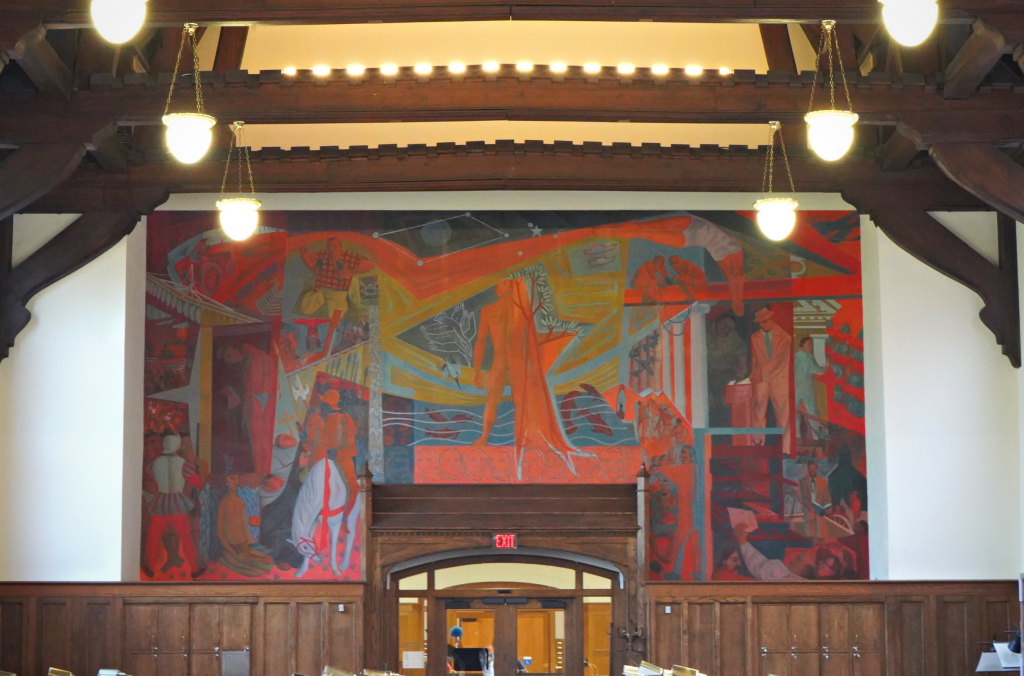
Similar to other libraries on campus, Smathers has three floors full of spaces that are open to undergraduate students of every major. Most of these spaces do not require any type of special access for studying, though you may be asked to put your bags away in a locker when you walk in.
Unlike the other libraries, the spaces in Smathers Library are individually named and all have their own look, feel, and requirements. Hours may differ between spaces, so check the Smathers Library Hours online for the specific part of the library you would like to visit.
Try to see them all before you graduate!
Map & Imagery Library (First Floor)
On the first floor, you’ll find the Map & Imagery Library. The Map & Imagery Library has small tables to study alongside friends while being surrounded by historic and current maps.
The items in this room are eye-catching and neat to look at, ranging from historic hand drawn maps to aerial photography of modern cities to globes of the planet Mars. You’ll even find maps of fictional universes, like Tolkien’s Middle Earth.
- Reservation required to enter? No.
- Food and drink allowed? No.
- Noise Level: Group study is allowed, the noise level is conversational.
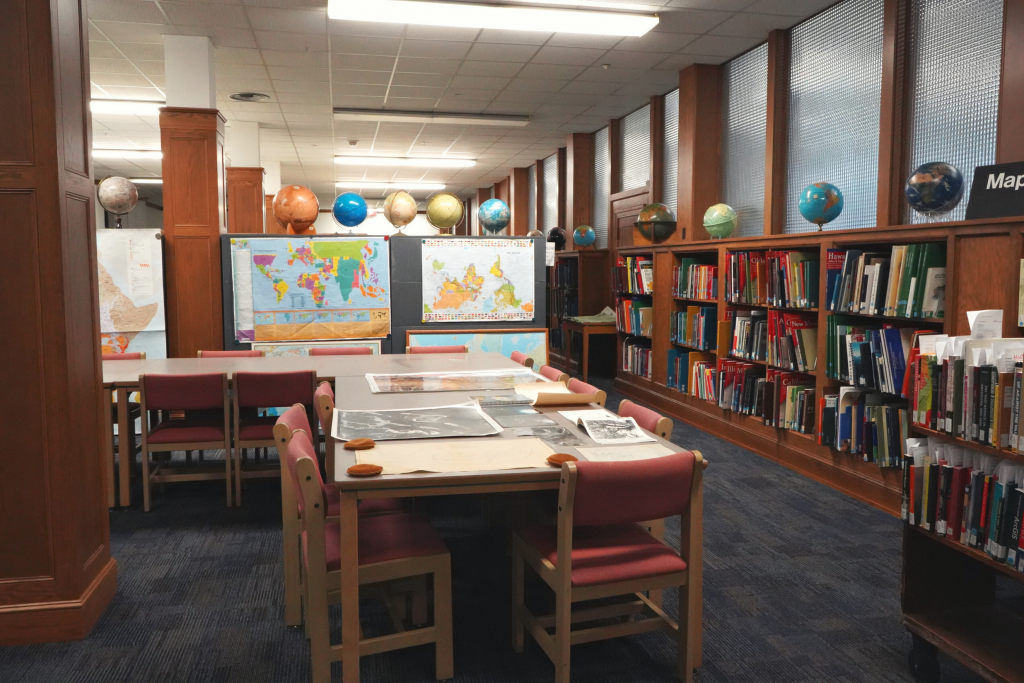
Albert H. Nahmad Panama Canal Gallery (First Floor)
Located right outside of the Map & Imagery Library is the Albert H. Nahmad Panama Canal Gallery. This space doubles as a place with small booths to get some work done between classes and as an exhibit gallery.
The Panama Canal Gallery features unique items from the collections on the history of the Panama Canal. The exhibits on display highlight personal stories of people who worked on the canal. Exhibits here change during the start of every spring semester. When we took a tour of Smathers Library, the Panama Canal Gallery featured the lives of people who lived in the Canal Zone during World War II after the bombing of Pearl Harbor.
This area is the place to be if you ever want to feel like you’re studying in a mini museum!
- Reservation required to enter? No.
- Food and drink allowed? Yes.
- Noise Level: Group study is allowed, though the area is fairly quiet.
- Grab a booth in the Panama Canal Gallery between classes.
- The exhibit hosted in the Panama Canal Gallery changes every spring semester.
Grand Reading Room (Second Floor)
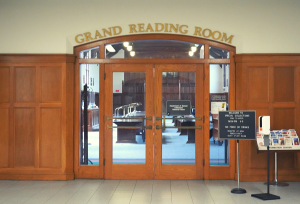
Moving up to the second floor of the library, you will find one of the most elegant places to study on UF campus: the Grand Reading Room. This room is the oldest part of the library and has been used for studying since 1925.
Initially, when you glance at this study space, you will see a double door that is closed. You may think that you require special access to get in, but you are welcome here. In reality, it is open to all undergraduate students! Something to keep in mind is that you need to ring the doorbell to unlock the door and be let in. The library takes this extra precaution since the reading room is home to thousands of special collections.
Additionally, if you want to study here you might want to finish your iced coffee before walking in. The Grand Reading Room has several archives that the library wants to keep intact and to do so, they require no food or drinks while you’re there. However, there are lockers to place your things in, and you are able to step outside to eat or drink when necessary.
Overall, this study space is perfect to get some quiet, independent studying done, and you even get your own designated table to study at as soon as you check in.
- Reservation required to enter? No, but you need to ring the doorbell and you will be assigned a table.
- Food and drink allowed? No.
- Noise Level: Silent, strictly enforced.
- Other policies: You will need to leave your bag in a locker by the door. No pens allowed, but you can get a pencil from the service desk!
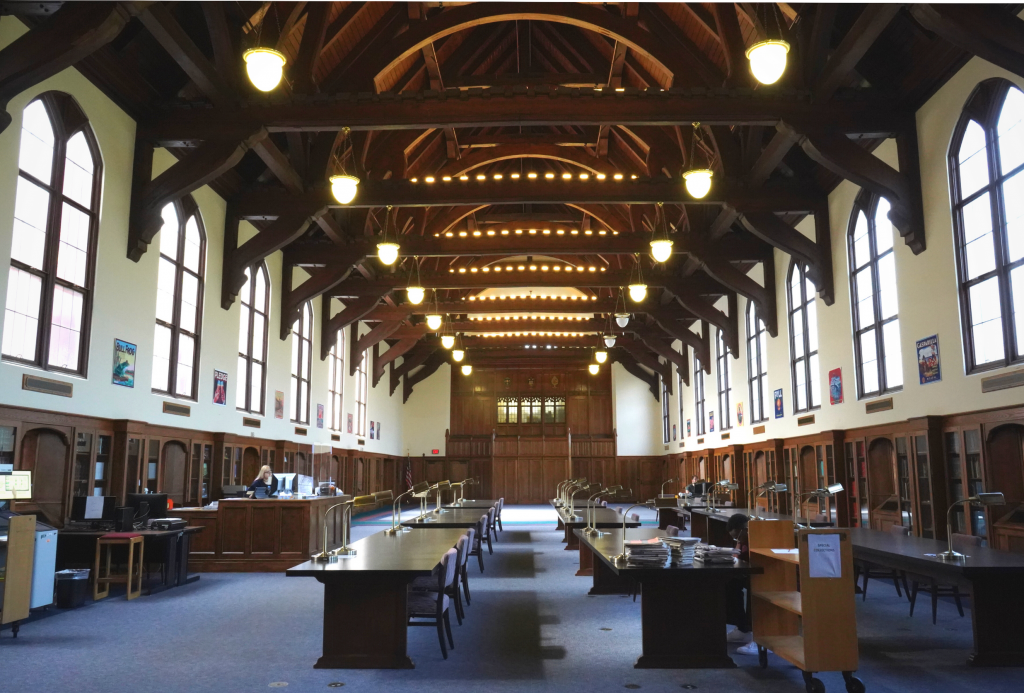
The Judaica Suite (Second Floor)
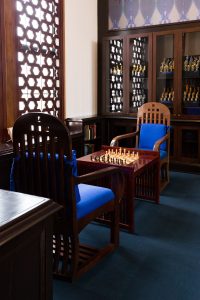
If you walk through the Grand Reading Room to the opposite side of the room, you’ll find one of the best kept secrets all of UF campus – the Judaica Suite.
With elegant carved windows, dark wooden tables, and two floors of open study area, the Judaica Suite is one of the most tranquil and exquisite spots in the libraries. It is the reading room for the special collections of the Isser and Rae Price Library of Judaica, which is the number one research collection on Jewish studies in the southeastern United States.
Part library, part museum, this space was designed by Kenneth Treister, the world-renowned architect and artist who designed the Holocaust Memorial in Miami Beach. In addition to the rare books about Jewish history and culture, you will also find handmade furniture, sculptures, and chess sets all created by Treister for the Suite.
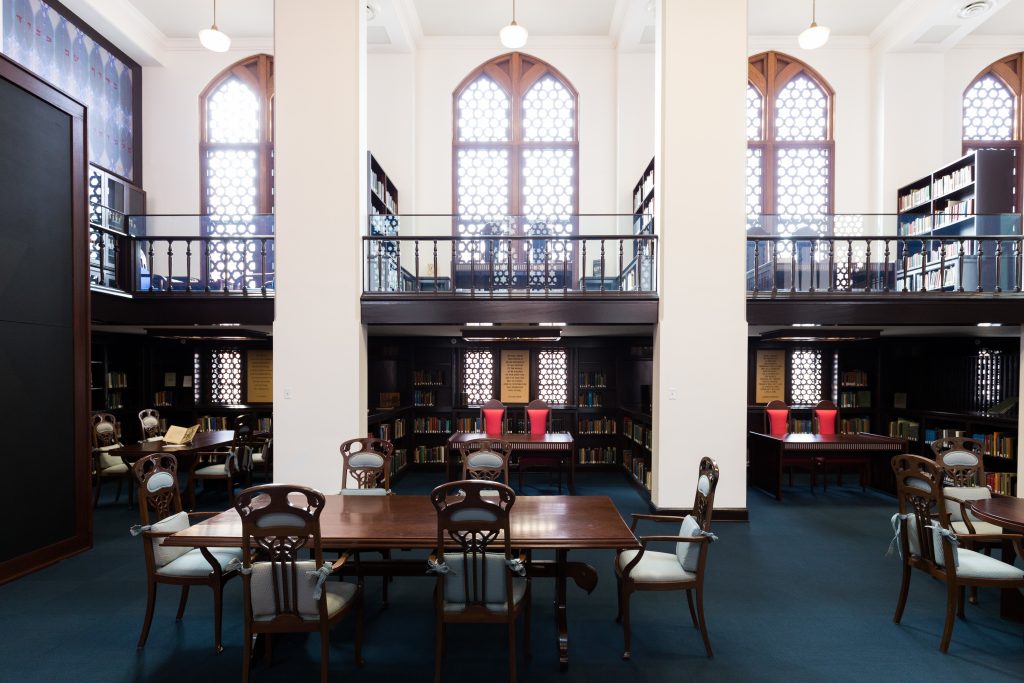
The Suite is open for walk-in visits on Fridays. On Mondays though Thursdays, the Judaica Suite is available by appointment only, but anyone can reserve an appointment. Contact the curator, Rebecca Jefferson, to book a time slot.
- Reservation required to enter? No reservation required on Fridays. Monday-Thursday, you can email Rebecca Jefferson for a reservation to use the space.
- Food and drink allowed? No.
- Noise Level: Quiet.
Interested in learning more about the Judaica Suite? Check out the video below:
Above: “Introduction to the UF Price Library of Judaica” by Rebecca Jefferson and the UF Libraries on YouTube. A permanent, archival version of this video is also available in the UF Digital Collections.
Latin American and Caribbean Collection (Third Floor)
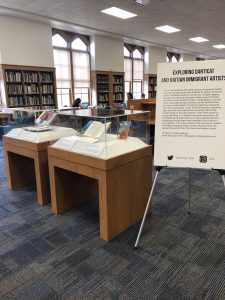
Last, but certainly not the least, is the third floor of Smathers known as the Latin American and Caribbean Collection (LACC) area. The LACC is one of the only research library collections in the United States devoted to Latin American and Caribbean materials. The library workers in the LACC are proud to host this space where Latinx students can connect with their culture.
The LACC has the largest open study space in Smathers Library and it is a favorite for many students. There are several tables spread throughout the floor, and there are even large tables with built-in outlets on the surface of them. You’ll find book displays and materials devoted to Latin American history, culture, and more in this space.
Although LACC is just as quiet as the second floor, you can still effectively study with a small group of friends as long you know how to whisper. The third floor of Smathers is a great place to get in some last minute studying right before an exam. LACC is an ideal study space at UF if you want the feeling of being immersed in an antique, classical library setting.
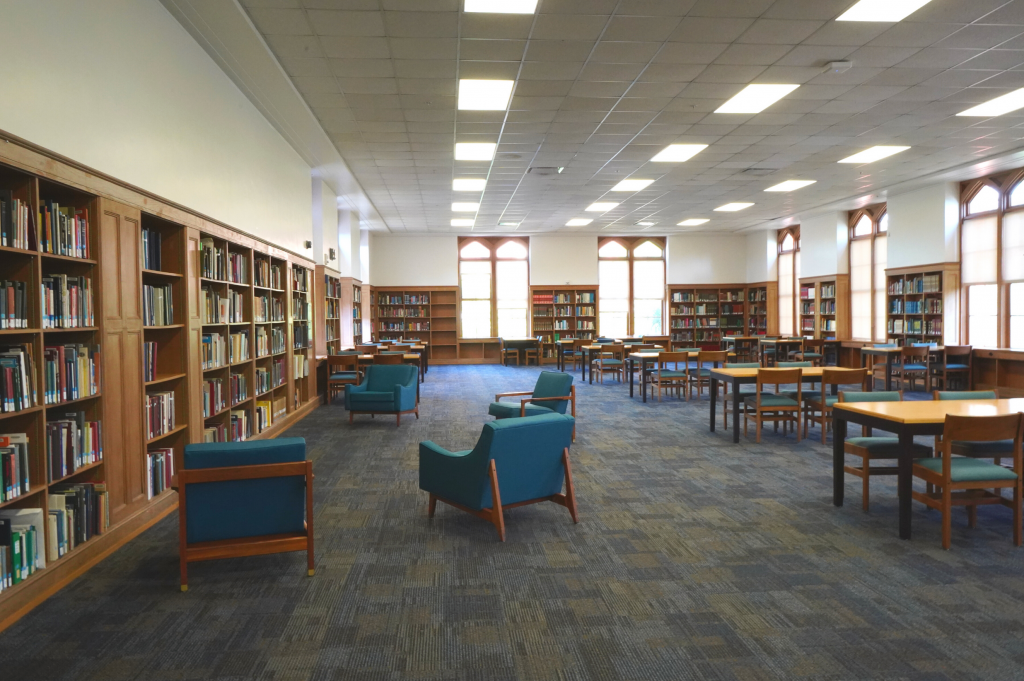
Collections and Research Help
Smathers is home to a remarkable assortment of special collections. Thousands of primary sources — including books, archives, maps, manuscripts, and more — are available to all students upon request.
You don’t need to be working on a research project to see and hold these items; the librarians at Smathers can help you explore special and historic collections just for the sake of your own curiosity!
Some of the most prominent special collections include:
- Baldwin Library of Historical Children’s Literature
- Latin American and Caribbean Collections
- Rare Book Collection
- Isser and Rae Price Library of Judaica
- Map and Imagery Library
- Panama Canal Museum Collection
- PK Yonge Library of Florida History
- African Studies
- Architecture Archives
- Manuscripts
- University Archives
- Popular Culture Collections
- New Testament in Latin (Rome, ca. 1250-60); Rare Book Collection.
- Wonder Woman Comics (1959 & 1994); Suzy Covey Comic Book Collection.
Unlike the other libraries on campus, there is no single or centralized service desk in Smathers Library because each individual space operates in its own way. However, there are desks where you can ask for help inside the Map & Imagery Library on the first floor, in the Grand Reading Room on the second floor, and in the Latin American and Caribbean Collection (LACC) on the third floor.
The best way to get help with research support is to reach out by email. If you don’t know where to start, you can reach out to a subject librarian or contact the general Special Collections email address listed below. There are lots of library workers in Smathers who can help you access the special items in this library!
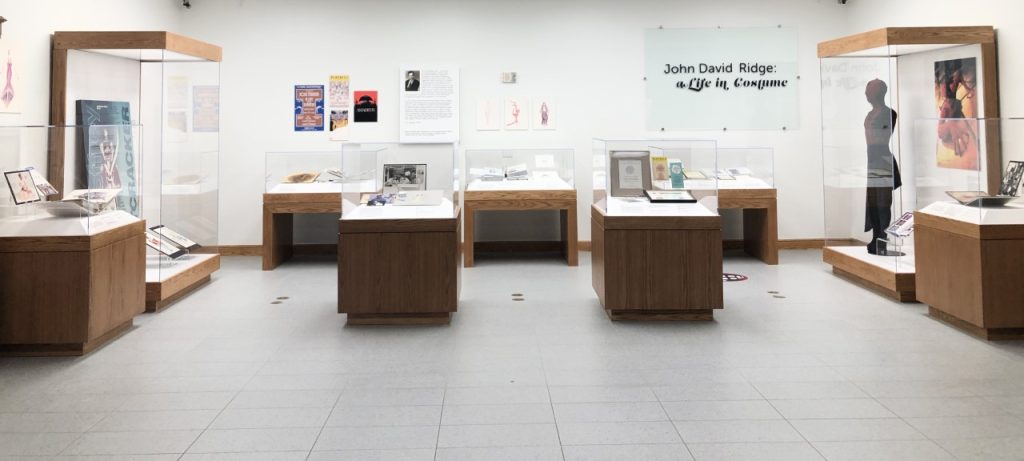
Don’t Miss Out!
Smathers Library has some of the most distinctive spaces on campus — if you know where to look.
The Grand Reading Room and Judaica Suite on the second floor are both beautiful, historic, and quiet places to study. The LACC on the third floor is a favorite to many students, especially if you want to read books from Latin America and the Caribbean. In the Map & Imagery Library, bright and colorful maps surround your table while you work.
Exhibits and displays are other points of interest at Smathers. The Albert H. Nahmad Panama Canal Gallery on the first floor incorporates primary sources, informational blurbs, and stunning visuals right alongside the study tables. Students often take study breaks to browse the displays. Additionally, the second floor accommodates an ever-shifting exhibit that curators rotate every few months, with topics ranging from sexuality to Florida history.
We highly recommend spending some time in each of the unique spaces in Smathers!
Message from a Smathers Curator
We have a wide variety of treasures in Smathers Library Building, including one-of-a-kind and rare historical materials, beautiful reading rooms, educational and entertaining exhibits, and perhaps most importantly, our wonderful librarians and staff who are available to assist you with their expert knowledge.
– John Nemmers, Curator of the Panama Canal Museum Collection
Special collections are the crossover between libraries and museums: these collections cannot be checked out and are usually historic materials, but they can be used in designated reading rooms in the library.
At UF, rare books, photographs, memorabilia, archives, and other items are housed in Special Collections in the Smathers Library. Undergraduate students are welcome to use these items in Smathers!
Pro Tip: Reach out to Special Collections ahead of time so that they can get the items you want to see ready for your arrival.
An exhibit is a public display of objects with accompanying cultural or educational information, found commonly in museums and libraries. In the Libraries at UF, exhibits highlight items found in our collections and tell a story or interpretation of their significance.
A primary source is an original, first-hand account of an event. Depending on the context, a primary source could be something like a diary, newspaper article, laboratory journal, or a social media post.
The service desk is the place where the magic happens. Check out items, ask questions about research, and get help with whatever you need from the friendly library workers at the main desk. Also called the “circulation desk.”
A subject librarian (or "subject/area specialist") is a librarian who has expertise in a particular subject, discipline, or topic. Every major at UF has a subject librarian who is uniquely qualified to help them with their research.

